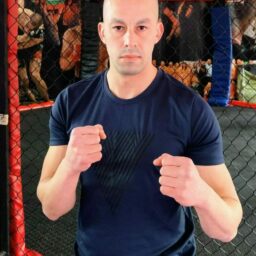Traditional BJJ is practiced in a gi, which leaves no questions about the proper clothing for training. But in no-gi BJJ, the choice is more complicated, and some clothing options are much better than others. So what should you wear for no-gi BJJ?
A short or long-sleeved BJJ-specific rash guard is optimal for a top in no-gi. Specially designed BJJ or MMA shorts or spats are the best solution for the bottom part of the clothing. This gear minimizes friction, reduces the chances of injury, and protects the skin from mat burns and diseases.
The proper clothing helps you train without restriction and prevent unpleasant minor injuries. The wrong clothing does the opposite, so knowing how to choose the appropriate attire for no-gi BJJ is good.
What To Wear For No Gi BJJ
The BJJ gi makes the choice of clothing for traditional BJJ easy, but for no-gi, the options are plenty. If you are committed to no-gi, the right set of clothes will make life on the mats easier and more pleasant, and they can save you from minor nuisances like mat burns and major problems like staph infections.
Rash Guard
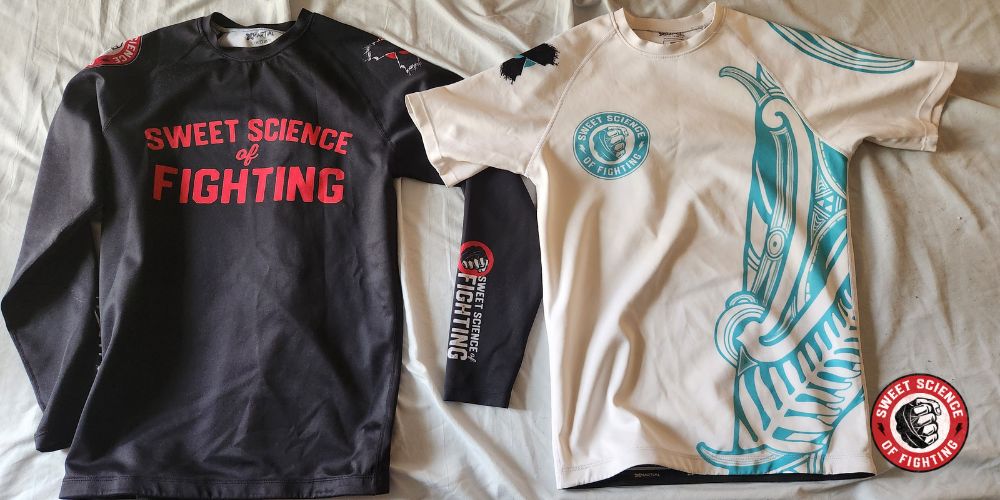
The rash guard is the most crucial piece of clothing for no-gi. It’s superior in every single way to other types of clothing for the purpose of grappling. Rash guards are tight-fitting, synthetic tops bringing so many benefits that they have become indispensable in BJJ.
You can find our best BJJ rash guards including our own Sweet Science of Fighting rash guard in collaboration with XMartial.
First, the tight-fitting fabric ensures the rash guard will always stay glued to the body and won’t catch fingers, arms, or feet. A good rash guard often has rubber anti-slip waistbands that prevent rolling up and minimize skin-to-skin contact.
The material protects the skin from mat burns, scrapes, and bruises common in rolling. Additionally, good-quality rash guards have antibacterial qualities to guard you against the many lurking germs on the mats, causing things like simple rashes, ringworm, or staph infections.
Lastly, BJJ rash guards come in cool designs, allowing you to express yourself or represent a team or academy.
BJJ-specific rash guards are more expensive than generic surfing or simple compression shirts. The extra money is worth it because of the visuals and because the BJJ rash guard is sturdier and built to withstand the constant friction with other people and the mats.
5 Step Blueprint To Build A BJJ Strength Workout To Demolish Your Opposition
Learn how to plan your strength training to maximize transfer to the mats.
There are different types of rash guards, like long-sleeved, short-sleeved, or no-sleeved, and the choice between them is personal. But if you plan on competing in no-gi tournaments, always first check the rules about the attire because there are often regulations on colors and lengths.
Shorts
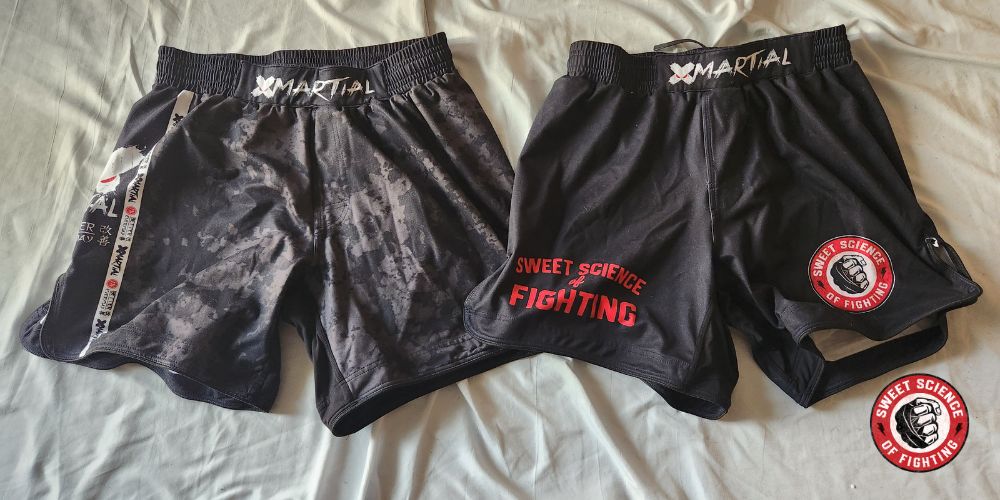
The standard bottom for no-gi BJJ is grappling shorts, also called fight shorts or MMA shorts. They can vary in length and material composition, but the common thing is all of them are designed with combat in mind. The materials are always light, synthetic, and sweat-wicking.
Fight shorts have no pockets, buttons, or other parts that can hurt someone. Velcro straps are always placed in a way to be away from any possible skin contact. Anti-slip bands are also common. Fight shorts are made for unobstructed movement and offer complete flexibility and mobility, which are necessary for grappling.
Spats
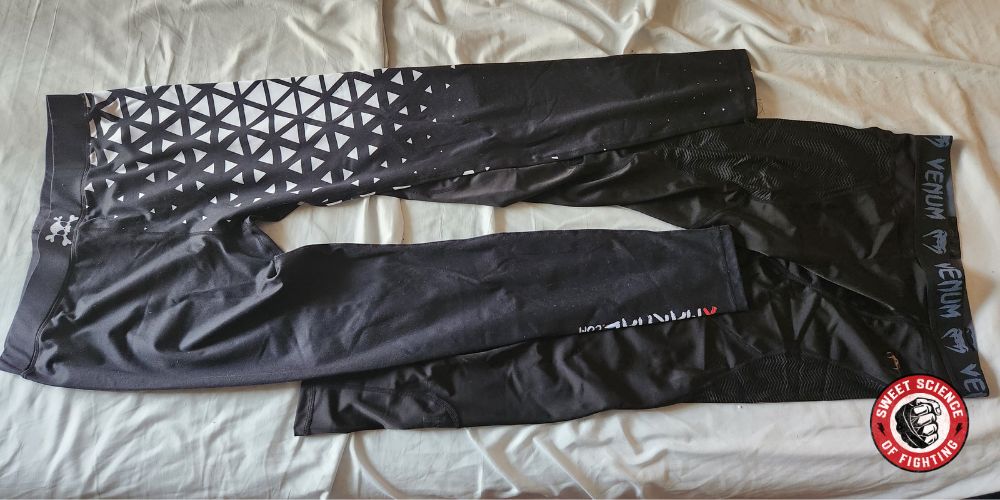
Spats are leg rash guards, or what some might call leggings for men. They are worn under your shorts, but you can train just with spats without any shorts during training. Keep in mind this is sometimes frowned upon.
Spats are long-sleeved, tight pants that do the same job as the rash guard: they prevent the skin from coming into contact with the skin of training partners and with the mat, thus decreasing the chances of bruises, scrapes, and infections.
Many people prefer spats because of the protection and because they have a compression effect, warming the muscles. Spats also help keep knee pads in place. I prefer to train in shorts, but many people, especially at higher belt levels, wear spats to training year-round, so they may be a worthwhile investment for you.
Optional No-Gi Equipment
Mouthguard
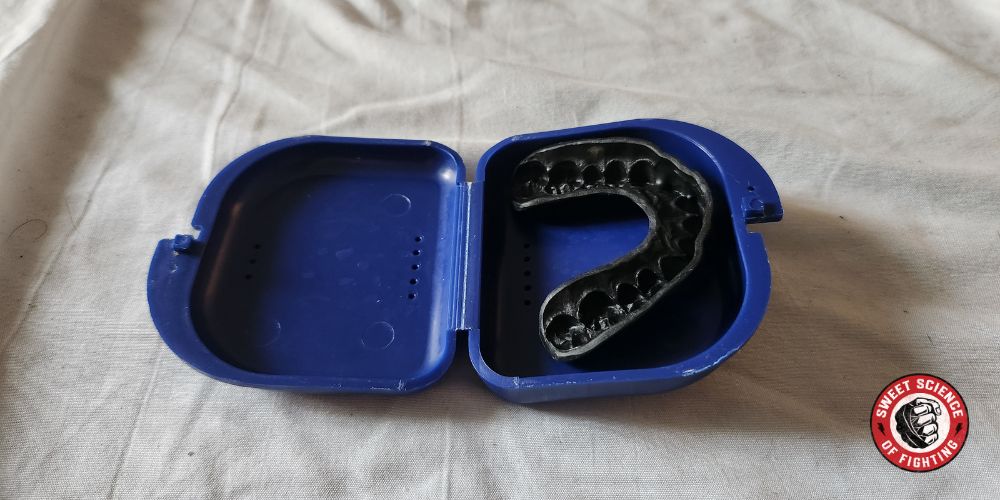
In my opinion, a mouthguard is not an optional piece of equipment but a mandatory one. However, you are not required to wear one, and no one will stop you from rolling without it. But the benefits of a mouthguard and the cheap price make it senseless to train without one unless you just forgot it at home.
Mouthguards are easily molded to each individual at home and protect the teeth and tongue. Chipped teeth can occur quickly during grappling from a takedown shot, a sloppily applied choke, or very commonly from a clash with a hard bone during scrambles.
The mouthguard also protects the teeth from grinding during a fall or an impact with a partner. So, there is no reason not to train with a mouthguard once you start sparring regularly.
Groin Cup
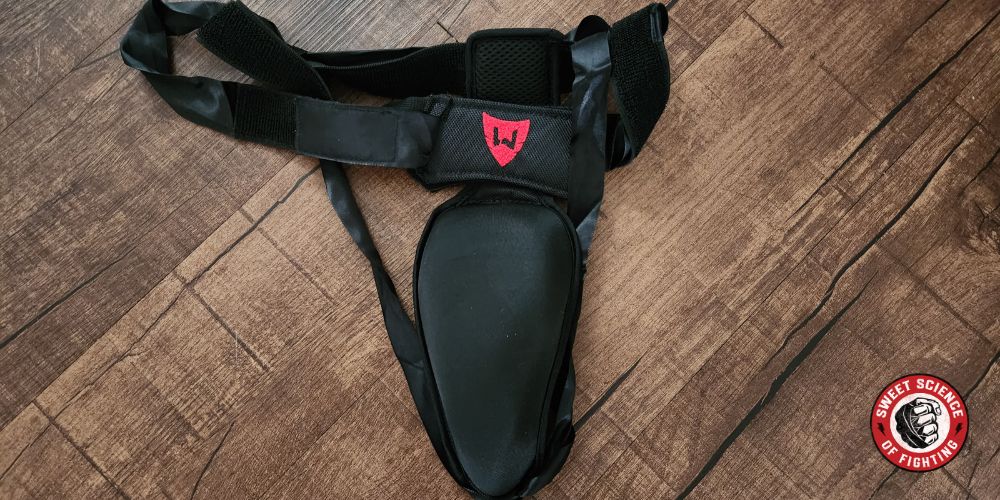
Groin cups are uncommon in BJJ because they are banned from most competition rulesets. The reasoning behind this decision is they provide an advantage for armbars in the form of an extra lever.
Additionally, they can damage training partners in certain positions, like triangles. On top of that, they hinder movement and are not comfortable at all for grappling.
With that said, in practice, you can use a cup if you need one or have an injury. I’ve spiked myself too many times on my knees during guard passes or takedowns and can appreciate a good cup, at least during MMA training.
So, if you have an injury or need to use a cup in training, it’s your choice. Just remember, you won’t be allowed to during the competition.
Kneepads
Kneepads and knee sleeves are also optional, and most people don’t wear them. But in no-gi, you will be scrambling and wrestling a lot, which may leave some scrapes and burns on your knees. Wrestlers who shoot a lot of takedowns with a knee hit on the mat often like to wear knee pads to protect themselves.
Another reason to wear kneepads or knee sleeves is to keep the knee joint more stable. I am yet to meet someone with more than 6 months’ worth of training who hasn’t had at least minor knee problems at some point. Knee sleeves can benefit the problematic knee and give you a sense of security.
With it, you can return to the mat after an injury sooner than otherwise. If you have weaker knees or like to go for aggressive wrestling-style takedowns, knee pads can significantly help.
Headgear
How many times have you seen BJJ guys wear headgear? I bet very little, but this shouldn’t be the case. Cauliflower ears are a real thing in BJJ, and even though some people view them as badges of honor, they are a real injury that is not only ugly but can impact your hearing.
The way to prevent cauliflower ears is by grappling specific headgear. Wrestlers have used ear guards for decades, and many good options exist.
BJJ headgear is not allowed in tournaments, so it’s not the best solution to get used to and use all the time. But after cauliflower ear treatment, having something to guard your ears until they recover is the only way to train.
I don’t use headgear because my ears are not susceptible to becoming cauliflower. Still, if, at a certain point, I had ear damage or went through treatment, I would consider buying some BJJ headgear.
What Not To Wear for No-Gi BJJ
While you can get away with wearing your everyday athletic clothing for the first few no-gi classes, and no one will expect you to show up with full BJJ gear in the first week, the types of clothing showcased in the first paragraph are what you should have if you are regular.
Some things in clothing have no place in the gym at all. On the top stop are zippers, buttons, and pockets. Zippers and buttons will surely scrape a training partner or the mats, while pockets provide traps for fingers and toes.
Even if you don’t buy specific BJJ or MMA-branded clothing for your no-gi practice, ensure your shorts and tops have no metal or plastic parts.
As for the top, the tighter the shirt, the better it is for BJJ. Loose, untucked tank tops get in the way and can trap a limb and cause a stupid injury easily prevented. Even cheap compression shirts or skin-tight athletic t-shirts are good and will do the job for no-gi BJJ, albeit not as well as a proper rash guard.
Summary
Having the right equipment for training lets you focus on the training itself and not worry about unnecessary things. Rash guards, fight shorts, and spats for men and leggings for women are the gold standard for no-gi BJJ attire.
If you are short on cash and can’t afford them, at least wear tight T-shirts and shorts with no pockets, zippers, or buttons.

